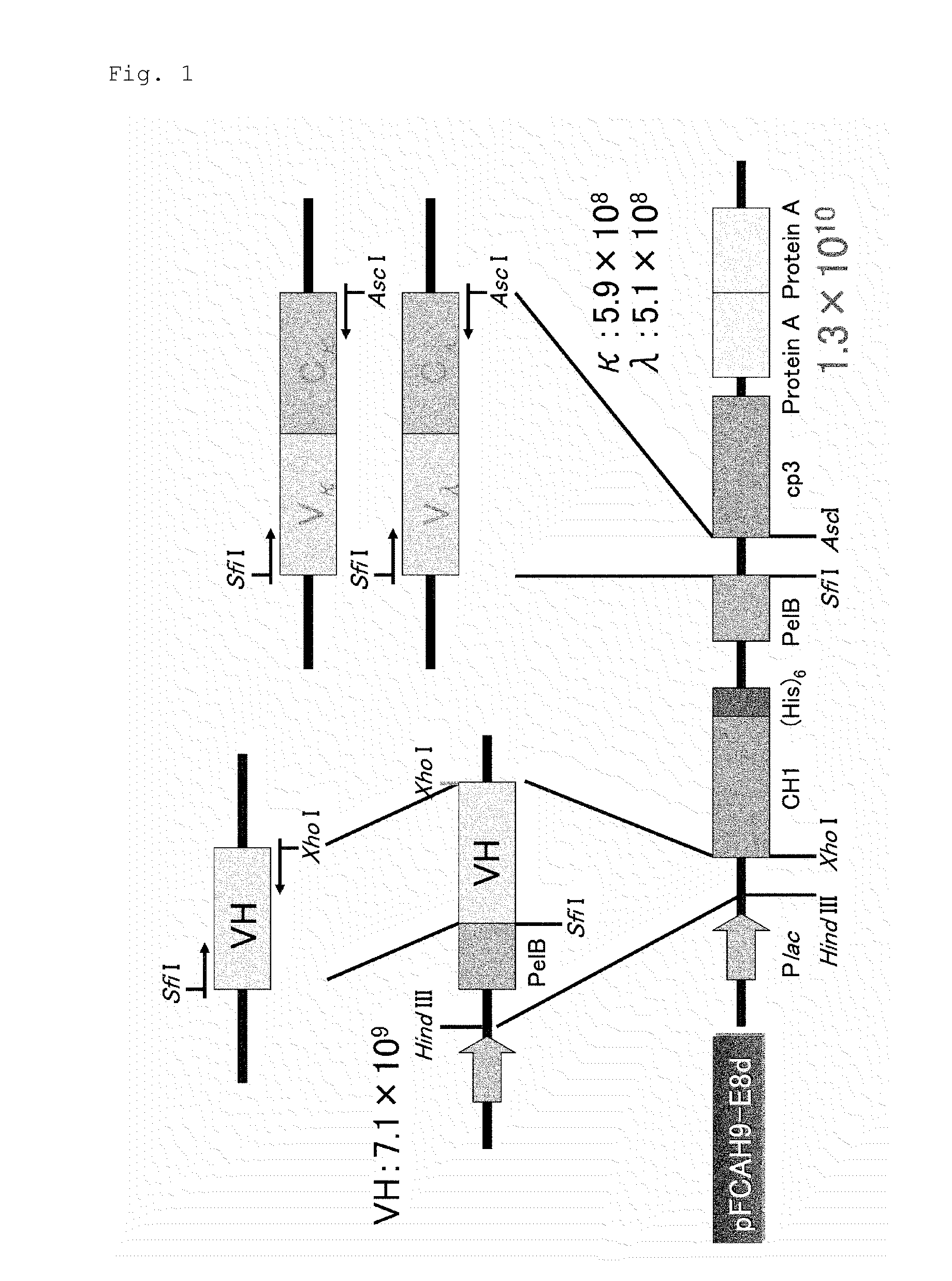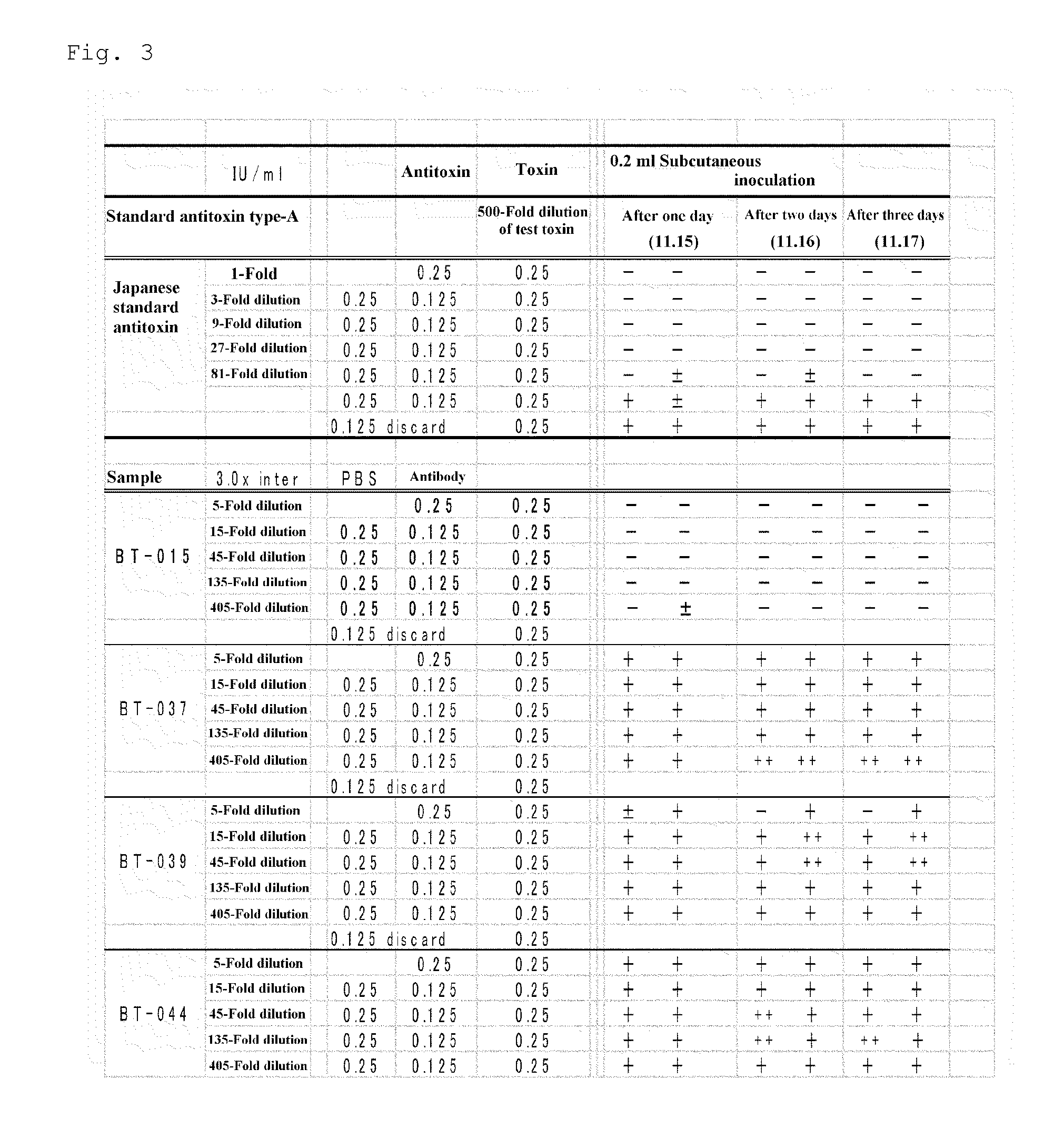Composition for neutralizing botulinus toxin type-A, and human anti-botulinus toxin type-A antibody
a technology of botulinus toxin and antibotulinus, which is applied in the field of composition for neutralizing botulinus toxin typea and human antibotulinus toxin typea antibodies, can solve the problems of unknown viral infections and serum diseases in the preparation, the danger of immunoreaction, and the difficulty of stable supply of this preparation
- Summary
- Abstract
- Description
- Claims
- Application Information
AI Technical Summary
Benefits of technology
Problems solved by technology
Method used
Image
Examples
examples
1. Preparation of Botulinum Toxoid Immune Antibody Library
1-1. Inoculation of Botulinum Toxoid to Human Volunteers
[0182]A toxoid was prepared by culturing Clostridium botulinum types A, B, E and F and using as the material the toxin obtained by purification of the resulting toxin. Especially, the type-A toxin was prepared by purifying a neurotoxin produced from Clostridium botulinum strain 97 (C. botulinum 97) or 62A (C. botulinum 62A) that has been currently used as a therapeutic toxin, according to the method performed in the B type neurotoxin (Infect. Immun. 18: 761-766, 1977). Each type of the purified toxins was inactivated with formalin, mixed with aluminum adjuvant to make a polyvalent mixed toxoid of precipitated ABEF types. This polyvalent toxoid was subcutaneously injected in 0.5 mL each as a basal immunity three times every 3-4 weeks and further once in 0.5 ml approximately 12 months later. Furthermore, ten years later and 20 years later, additional injections were made, ...
experiment 1
2-1. Screening Experiment 1
(1) Selection / Collection of Specific Clones
[0194]In order to obtain a neutralizing antibody, it is ideal to screen an antibody binding to the site of neurotoxin having a neural toxin activity. However, in a volunteer blood donor who has been immunized with a toxoid prepared with a full length of the toxin, an antibody that binds to the nontoxic protein component (the antibody that is unnecessary here) has also been produced in the body. In addition, the availability of the neurotoxin having a neural toxin activity is limited, too. Then, a screening strategy was employed, which comprises, first, reacting a nontoxic protein component with a human antibody library to absorb the unnecessary antibody in the nontoxic protein component, collecting the reaction supernatant, and then reacting the botulinum toxoid with the human antibody library that had not been absorbed in the nontoxic protein component.
[0195]At first, each 100 μl of botulinum toxoid and nontoxic ...
experiment 2
2-2. Screening Experiment 2
[0207]Among the antibodies obtained in the screening experiment 1, a mixture of the antibody proteins of 19 clones which had been judged to be negative (antibodies that react to the nontoxic site) was prepared by the following method.
[0208]At first, DNAs of the 19 clones were mixed, digested with a restriction enzyme SalI, converted into an Fab-pp type antibody by self-recombining, and then DH12S was transformed using this antibody. After the transformation, the transformant was cultured in 100 ml of 2xYTGA culture medium at 30° C. overnight. This culture solution of 40 ml was mixed with 4 liters of 2xYTA culture medium and cultured for 3 hours, 2 ml of 1M IPTG was added and cultured at 30° C. for 20 hours. The culture solution was centrifuged at 8000 rpm for 10 minutes at 4° C. to collect a supernatant. After adding 2244 g of ammonium sulfate slowly to the collected supernatant, the mixture was stirred at room temperature for one hour, and centrifuged at ...
PUM
| Property | Measurement | Unit |
|---|---|---|
| concentrations | aaaaa | aaaaa |
| concentrations | aaaaa | aaaaa |
| body weight | aaaaa | aaaaa |
Abstract
Description
Claims
Application Information
 Login to View More
Login to View More - R&D
- Intellectual Property
- Life Sciences
- Materials
- Tech Scout
- Unparalleled Data Quality
- Higher Quality Content
- 60% Fewer Hallucinations
Browse by: Latest US Patents, China's latest patents, Technical Efficacy Thesaurus, Application Domain, Technology Topic, Popular Technical Reports.
© 2025 PatSnap. All rights reserved.Legal|Privacy policy|Modern Slavery Act Transparency Statement|Sitemap|About US| Contact US: help@patsnap.com



